【.NET类库】通过SharpSocket进行TCP/UDP通信数据传输
类库作用:
用于基于TCP/UDP协议的数据通信,调用简单,高效。 封装了和业务无关的底层细节,让开发人员可以专注于做业务
完善的示例代码:
针对类库的几种用法,都提供了较为详细的示例代码

一、TCP收发二进制数据:
(服务端)
通过SocketFactory工厂对象,得到一个BinaryTcpServer实例,参数为 监听的端口号。
然后给tcpServerIntance对象绑定事件, 如客户端数量变更、客户端已连接、客户端失连接、收到客户端消息等等
#region 获取ITcpServer的示例 if (tcpServerIntance == null) { tcpServerIntance = SocketFactory.GetBinaryTcpServer(int.Parse(txtPort.Text.Trim()), new BinaryFormattHelper()); //绑定事件 this.tcpServerIntance.ClientCountChanged += new SGDelegate<int>(ClientCountChanged); this.tcpServerIntance.ClientConnected += new SGDelegate<System.Net.IPEndPoint>(ClientConnected); this.tcpServerIntance.ClientDisconnected += new SGDelegate<System.Net.IPEndPoint>(ClientDisconnected); this.tcpServerIntance.MessageReceived += new SGDelegate<IPEndPoint, byte[]>(MessageReceived); } #endregion
(客户端)
通过SocketFactory工厂对象,创建一个BinaryTcpClient客户端对象,参数为服务端的IP,服务端的端口号
然后给clientInstance对象绑定相关的事件方法,如断开连接、重连成功等
//获取tcp客户端接口实例 clientInstance = SocketFactory.GetBinaryTcpClient(this.txtIP.Text, int.Parse(this.txtPort.Text), new BinaryFormattHelper()); //绑定事件 clientInstance.MessageReceived += new SGDelegate<System.Net.IPEndPoint, byte[]>(MessageReceived); clientInstance.ConnectionDisconnected += new SGDelegate(ConnectionInterrupted); clientInstance.ConnectionReconnectSucceed += new SGDelegate(ConnectionRebuildSucceed); //启动掉线自动重连 clientInstance.AutoReconnect = true; //开始初始化,SharpSocket将初始化和服务端的连接 clientInstance.Initialize();
为了方便演示效果,服务端和客户端分别都做成了WinForm窗体应用程序,这样看起来更直观:
启动服务端,启动之后服务端会监听本机9000端口。
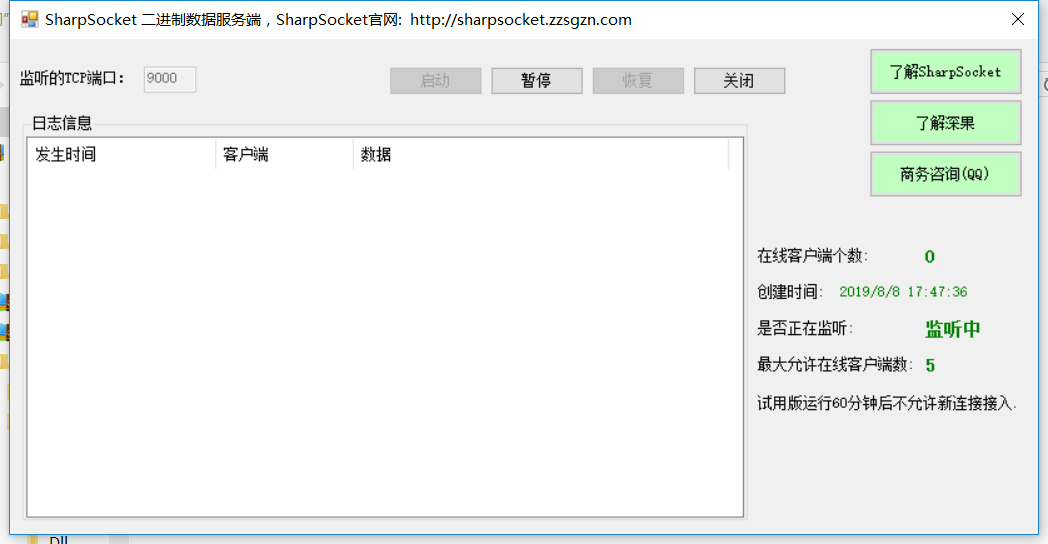
然后启动一个客户端,IP默认本机IP,端口号为服务端的监听端口9000,点击“连接”按钮,提示连接成功
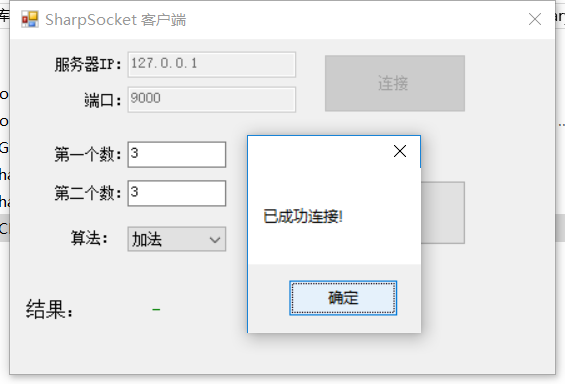
此时看一下服务端的界面,会发现服务端监测到了客户端的连接。
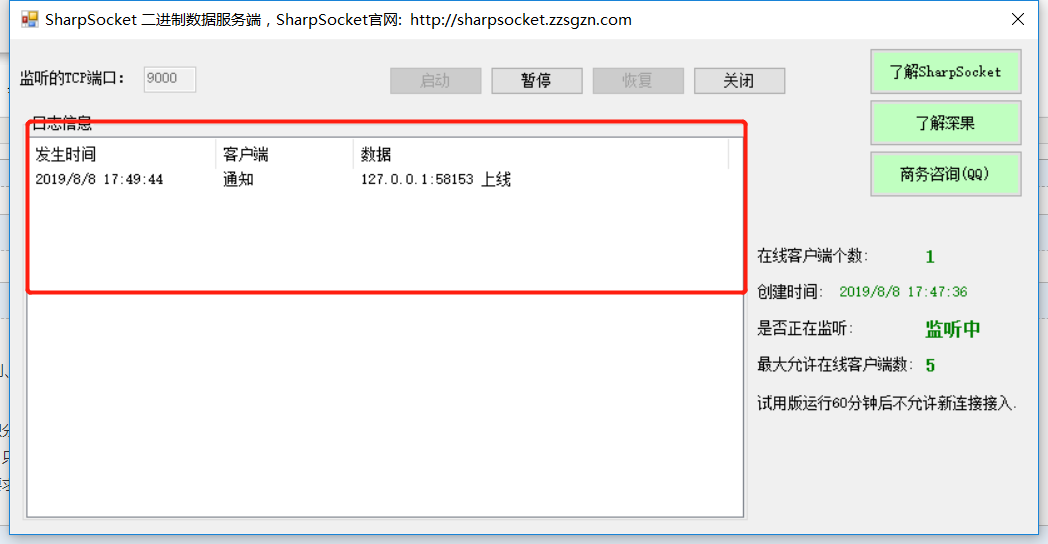
数据传输:
我们在客户端选择两个数字,然后选择一个运算符号,把这些信息发送给服务端,我们期望服务端接受这些信息,执行相应的计算,并返回计算结果给客户端
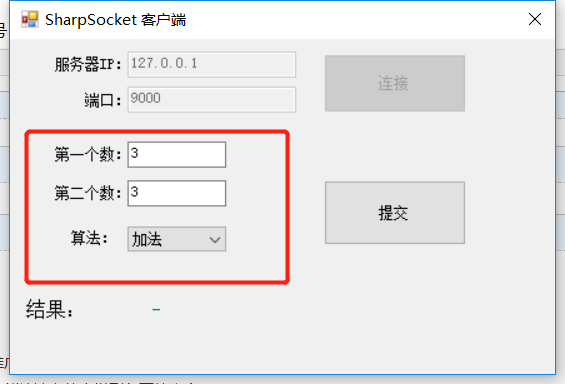
点击提交
可以看到运算的结果已经从服务端获取
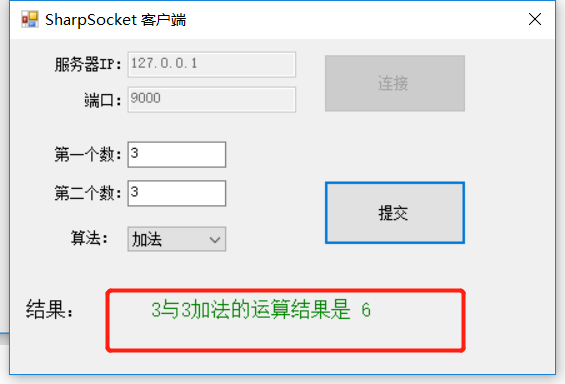
数据是如何从客户端传给服务端?服务端又是如何返回结果给客户端呢?
(客户端发送数据给服务端)
//请求消息体 RequestFormat contract = new RequestFormat(int.Parse(this.textBox1.Text), int.Parse(this.textBox2.Text)); byte[] bBody = SerializeHelper.SerializeObject(contract); //消息头 MessageHead head = new MessageHead(bBody.Length, msgType); byte[] bHead = head.ToStream(); //构建请求消息 byte[] reqMessage = new byte[bHead.Length + bBody.Length]; Buffer.BlockCopy(bHead, 0, reqMessage, 0, bHead.Length); Buffer.BlockCopy(bBody, 0, reqMessage, bHead.Length, bBody.Length); //发送请求消息 clientInstance.PostDataToServer(reqMessage);
(服务端返回数据给客户端)
//回复消息体 ResponseFormat response = new ResponseFormat(request.Number1, request.Number2, operationType, result); byte[] bReponse = SerializeHelper.SerializeObject(response); //回复消息头 MessageHead head = new MessageHead(bReponse.Length, MessageType.Result); byte[] bHead = head.ToStream(); //构建回复消息 byte[] resMessage = new byte[bHead.Length + bReponse.Length]; Buffer.BlockCopy(bHead, 0, resMessage, 0, bHead.Length); Buffer.BlockCopy(bReponse, 0, resMessage, bHead.Length, bReponse.Length); //发送回复消息 tcpServerIntance.PostDataToClient(client, resMessage);
可以看到,都是通过byte[]的形式进行数据传递的,用于传递的byte[]代表一个消息,消息包含消息头和消息体,消息头是固定长度的,具体长度要根据服务端和客户端直接商定的协议来确定
在实例代码中,消息头的长度HeadLength为8位
二、TCP收发文本数据
服务端:
创建TextTcpServer对象,绑定事件,然后启动监听
#region 获取ITcpServer的示例 if (tcpServerIntance == null) { //DefaultTextFormatHelper是自带的使用UTF8编码,兼容中英文 tcpServerIntance = SocketFactory.GetTextTcpServer(int.Parse(txtPort.Text.Trim()), new DefaultTextFormatHelper("\0")); //绑定事件 this.tcpServerIntance.ClientCountChanged += new SGDelegate<int>(ClientCountChanged); this.tcpServerIntance.ClientConnected += new SGDelegate<System.Net.IPEndPoint>(ClientConnected); this.tcpServerIntance.ClientDisconnected += new SGDelegate<System.Net.IPEndPoint>(ClientDisconnected); this.tcpServerIntance.MessageReceived += new SGDelegate<IPEndPoint, byte[]>(MessageReceived); } #endregion #region 启动监听 tcpServerIntance.Initialize(); #endregion
客户端:
创建TextTcpClient对象,绑定事件,执行Initialize()初始化方法
//初始化并启动客户端引擎(TCP、文本协议) clientInstance = SocketFactory.GetTextTcpClient(this.txtIP.Text, int.Parse(this.txtPort.Text), new DefaultTextFormatHelper("\0")); clientInstance.MessageReceived += new SGDelegate<System.Net.IPEndPoint, byte[]>(MessageReceived); clientInstance.AutoReconnect = true;//启动掉线自动重连 clientInstance.ConnectionDisconnected += new SGDelegate(ConnectionDisconnected); clientInstance.ConnectionReconnectSucceed += new SGDelegate(ConnectionRebuildSucceed); clientInstance.Initialize();
演示效果:
启动服务端并监听端口

启动客户端并连接端口
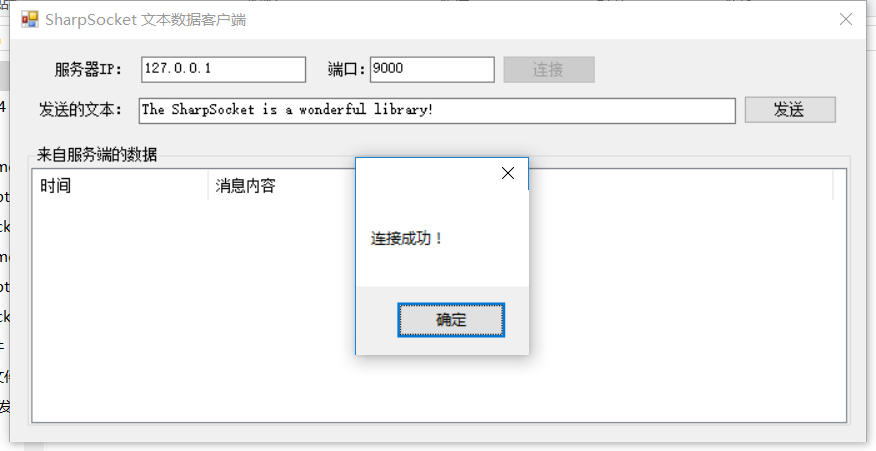
连接成功之后,服务端会有上线提示,并且会自动记录上线客户端数量
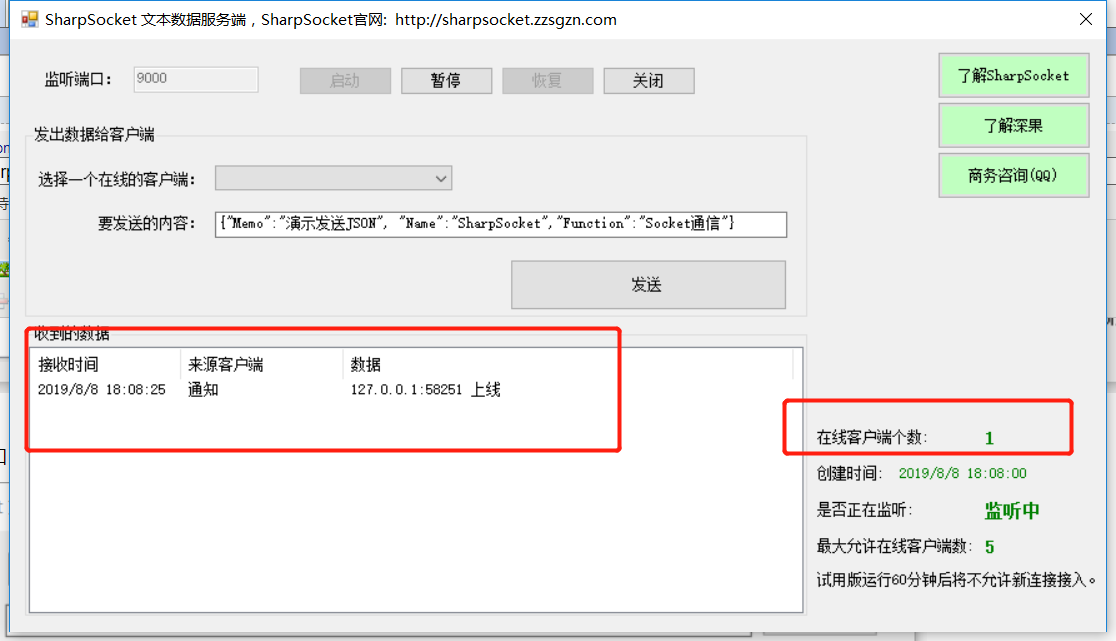
客户端尝试一下向服务端发送数据,服务端接收到了客户端发送的数据,并展示
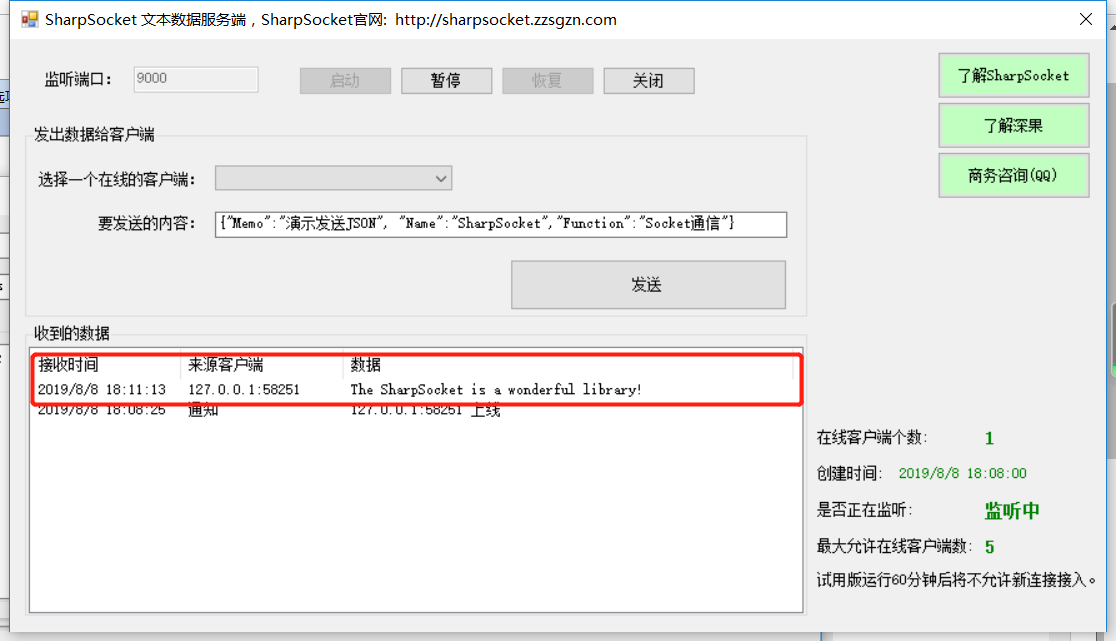
尝试一下服务端向客户端发送数据,试试发送json字符串。
客户端收到了服务端发送的json字符串
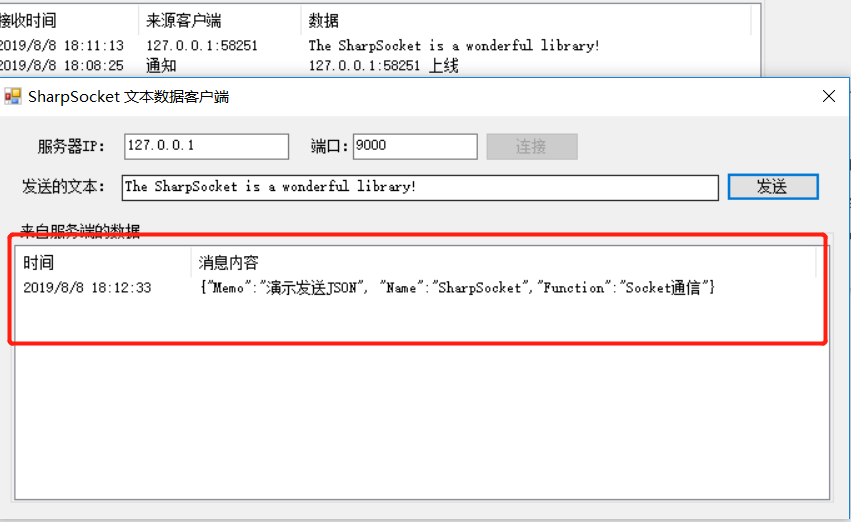
那么客户端具体是如何把数据发送给服务端?服务端又是如何进行回复的呢?
客户端发送数据
//将待发送的原始字符串加上 "\0"字符,代表一帧的结尾,方便服务端根据这个来过滤 string msg = this.txtMsg.Text + "\0"; //使用UTF-8编码数据 byte[] bMsg = System.Text.Encoding.UTF8.GetBytes(msg); //发走 clientInstance.SendDataToServer(bMsg);
服务端接受数据
//使用UTF-8编码 string msg = System.Text.Encoding.UTF8.GetString(bMsg); //将结束标记"\0"去掉,得到的就是原始字符串 msg = msg.Substring(0, msg.Length - 1);
服务端回复数据
//原始要发送的字符串加上一个结尾字符,由于使用的是DefaultTextFormatHelper,因此这里用"\0" 表示一个消息的结尾 string msg = this.textBox_msg.Text + "\0"; //DefaultTextFormatHelper使用UTF-8编码 byte[] bMsg = System.Text.Encoding.UTF8.GetBytes(msg); tcpServerIntance.SendDataToClient(client, bMsg);
可以看到,在进行字符串、json或者xml等一些非结构化的数据传输时,也是先将内容转化成字节数组。
与TCP的二进制数据传输不同的时,这里不区分消息头和消息体,只是由客户端和服务端预定义了帧的结束符,在每一帧消息的末尾加上这个结束符,方便服务端和客户端进行解析
三、UDP收发任意数据
基于UDP协议的数据通讯,不需要客户端提前建立连接
(服务端)
服务端通过SocketFactory.GetUdp()方法,创建UDP通信实例,并设定本端使用的端口号,注册消息事件并初始化
//创建一个接口实例,然后就可以操作它了 udpServerInstance = SocketFactory.GetUdp(); //设置本端使用的端口号 udpServerInstance.Port = int.Parse(this.edtPort.Text); //订阅本接口的收到数据的事件通知,当收到数据后,自动回调您注册的方法 udpServerInstance.MessageReceived += new SGDelegate<IPEndPoint, byte[]>(MessageReceived); //启动即可 udpServerInstance.Initialize();
(客户端)
根据IP和端口号创建服务端终结点,通过SocketFactory.GetUdp()创建UDP实例
//得到服务端终结点 serverEndPoint = new IPEndPoint(IPAddress.Parse(this.edtIP.Text), int.Parse(this.edtPort.Text)); if (this.udpClientInstance == null) { //初始化并启动客户端引擎(UDP) udpClientInstance = SocketFactory.GetUdp(); //订阅接收到数据的事件 udpClientInstance.MessageReceived += new SGDelegate<System.Net.IPEndPoint, byte[]>(MessageReceived); //启动UDP连接 udpClientInstance.Initialize();
客户端根据用户请求,构建消息头和消息体,并调用udpClientInstance.SendData(serverEndPoint,reqMessage);方法向服务端发送数据
int msgType = this.cmdOpType.SelectedIndex == 0 ? MessageType.Add : MessageType.Multiple; //请求消息体 RequestFormat contract = new RequestFormat(int.Parse(this.edtFirst.Text), int.Parse(this.edtSecond.Text)); byte[] bBody = SerializeHelper.SerializeObject(contract); //消息头 MessageHead head = new MessageHead(bBody.Length, msgType); byte[] bHead = head.ToStream(); //构建请求消息 byte[] reqMessage = new byte[bHead.Length + bBody.Length]; Buffer.BlockCopy(bHead, 0, reqMessage, 0, bHead.Length); Buffer.BlockCopy(bBody, 0, reqMessage, bHead.Length, bBody.Length); //发送请求消息 udpClientInstance.SendData(serverEndPoint, reqMessage);
服务端收到数据之后,解析收到的信息,执行相应的运算操作,并把结果返回给客户端
#region 解析消息体 RequestFormat request = (RequestFormat)SerializeHelper.DeserializeBytes(bMsg, MessageHead.HeadLength, bMsg.Length - MessageHead.HeadLength); int result = 0; string operationType = ""; if (msgType == MessageType.Add) { result = request.Number1 + request.Number2; operationType = "加法"; } else if (msgType == MessageType.Multiple) { result = request.Number1 * request.Number2; operationType = "乘法"; } else { operationType = "错误的操作类型"; } #endregion #region 显示请求 string msg = string.Format("请求类型:{0},操作数1:{1},操作数2:{2}", operationType, request.Number1 , request.Number2); ShowStr(client, msg); #endregion #region 回复消息体 ResponseFormat response = new ResponseFormat(request.Number1, request.Number2, operationType, result); byte[] bReponse = SerializeHelper.SerializeObject(response); #endregion #region 回复消息头 MessageHead head = new MessageHead(bReponse.Length, MessageType.Result); byte[] bHead = head.ToStream(); #endregion #region 构建回复消息 byte[] resMessage = new byte[bHead.Length + bReponse.Length]; Buffer.BlockCopy(bHead, 0, resMessage, 0, bHead.Length); Buffer.BlockCopy(bReponse, 0, resMessage, bHead.Length, bReponse.Length); #endregion #region 发送回复消息 udpServerInstance.SendData(client, resMessage); #endregion




